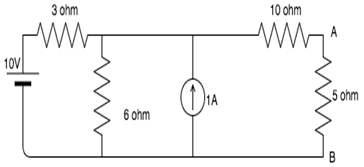This set of Basic Electrical Engineering Multiple Choice Questions & Answers (MCQs) focuses on “Norton’s Theorem”.
1. The Norton current is the_______
a) Short circuit current
b) Open circuit current
c) Open circuit and short circuit current
d) Neither open circuit nor short circuit current
View Answer
Explanation: Norton current is obtained by shorting the specified terminals. So, it is the short circuit current. It is not the open circuit current because if specified terminals get open circuited then current is equal to zero.
2. Norton resistance is found by?
a) Shorting all voltage sources
b) Opening all current sources
c) Shorting all voltage sources and opening all current sources
d) Opening all voltage sources and shorting all current sources
View Answer
Explanation: Ideal current sources have infinite internal resistance hence behave like an open circuit whereas ideal voltage sources have zero internal resistances hence behave as a short circuit. So, to obtain Norton resistance, all voltage sources are shorted and all current sources are opened.
3. Norton’s theorem is true for __________
a) Linear networks
b) Non-Linear networks
c) Both linear networks and nonlinear networks
d) Neither linear networks nor non-linear networks
View Answer
Explanation: Norton’s theorem works for only linear circuit elements and not non-linear ones such as BJT, semiconductors etc.
4. In Norton’s theorem Isc is__________
a) Sum of two current sources
b) A single current source
c) Infinite current sources
d) 0
View Answer
Explanation: Norton’s theorem states that a combination of voltage sources, current sources and resistors is equivalent to a single current source IN and a single parallel resistor RN.
5. Isc is found across the ____________ terminals of the network.
a) Input
b) Output
c) Neither input nor output
d) Either input or output
View Answer
Explanation: According to Norton’s theorem, Isc is found through the output terminals of a network and not the input terminals.
6. Can we use Norton’s theorem on a circuit containing a BJT?
a) Yes
b) No
c) Depends on the BJT
d) Insufficient data provided
View Answer
Explanation: We can use Norton’s theorem only for linear networks. BJT is a non-linear network hence we cannot apply Norton’s theorem for it.
7. Calculate the Norton resistance for the following circuit if 5 ohm is the load resistance.

a) 10 ohm
b) 11 ohm
c) 12 ohm
d) 13 ohm
View Answer
Explanation: Shorting all voltage sources and opening all current sources we have:
RN=(3||6)+10 = 12 ohm.
8. Calculate the short circuit current is the 5 ohm resistor is the load resistance.

a) 0.72A
b) 0.32A
c) 0.83A
d) 0.67A
View Answer
Explanation: Since the 5 ohm is the load resistance, we short it and find the resistance through the short.
If we apply source transformation between the 6 ohm resistor and the 1A source, we get a 6V source in series with a 6 ohm resistor. Now we have two meshes. Let us consider I1 flowing in the first mesh and I2 flowing in the second mesh.
The mesh equations are:
9I1-6I2=4
-6I1+16I2=6
On solving these equations simultaneously, we get I2=0.72A, which is the short circuit current.
9. Find the current in the 5 ohm resistance using Norton’s theorem.

a) 1A
b) 1.5A
c) 0.25A
d) 0.5A
View Answer
Explanation: Shorting all voltage sources and opening all current sources we have:
RN=(3||6)+10 = 12 ohm.
Since the 5 ohm is the load resistance, we short it and find the resistance through the short.
If we apply source transformation between the 6 ohm resistor and the 1A source, we get a 6V source in series with a 6 ohm resistor. Now we have two meshes. Let us consider I1 flowing in the first mesh and I2 flowing in the second mesh.
The mesh equations are:
9I1-6I2=4
-6I1+16I2=6
On solving these equations simultaneously, we get I2=0.72A, which is the short circuit current.
Connecting the current source in parallel to RN which is in turn connected in parallel to the load resistance=5ohm, we get Norton’s equivalent circuit.
Using current divider: I = 0.72*12/(12+5) = 0.5 A.
10. Which of the following is also known as the dual of Norton’s theorem?
a) Thevenin’s theorem
b) Superposition theorem
c) Maximum power transfer theorem
d) Millman’s theorem
View Answer
Explanation: Thevenin’s theorem is also known as the dual of Norton’s theorem because in Norton’s theorem we find short circuit current which is the dual of open circuit voltage-what we find in Thevenin’s theorem.
Sanfoundry Global Education & Learning Series – Basic Electrical Engineering.
To practice all areas of Basic Electrical Engineering, here is complete set of 1000+ Multiple Choice Questions and Answers.
If you find a mistake in question / option / answer, kindly take a screenshot and email to [email protected]
